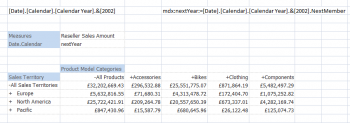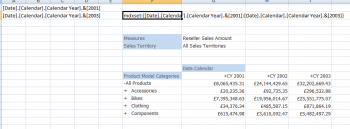Difference between revisions of "Mdx:"
(→Syntax) |
|||
| Line 28: | Line 28: | ||
| The Mdx snippet to run. | | The Mdx snippet to run. | ||
|} | |} | ||
| + | |||
| + | ==Examples== | ||
Valid examples you be: | Valid examples you be: | ||
| Line 37: | Line 39: | ||
|- | |- | ||
| [[Image:MdxColon.png|350px|centre]] | | [[Image:MdxColon.png|350px|centre]] | ||
| − | |||
| [[Image:MdxSetColon.png|350px|centre]] | | [[Image:MdxSetColon.png|350px|centre]] | ||
|} | |} | ||
Revision as of 17:46, 31 January 2013
Description
The Mdx: or Mdx Colon feature allows you to easily combine snippets of Mdx with your existing XLCubed Grids and other report objects.
The Mdx: statement could be a fixed piece of text, or created by using an Excel formula.
You can use this to create members or sets depending on your requirements.
Syntax
The Mdx: statement is made up of two or three parts.
| Part | Optional? | Description |
|---|---|---|
| Mdx: or MdxSet: | No | Select based on whether your mdx snippet returns a single member or a set of members. |
| Caption:= | Yes | Puts a user friendly caption against the member when it is returned. |
| Mdx | No | The Mdx snippet to run. |
Examples
Valid examples you be:
- Mdx:nextYear:=[Date].[Calendar].[Calendar Year].&[2002].NextMember
- Mdxset:{[Date].[Calendar].[Calendar Year].&[2001]:[Date].[Calendar].[Calendar Year].&[2003]}

